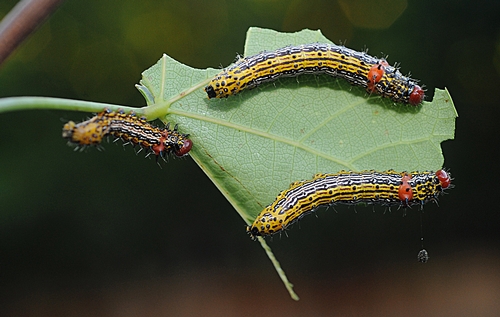There's a whole lot of crunchin' going on.
The redhumped caterpillar has discovered our redbud tree, which it considers an "all-you-can" buffet.
Now this is a voracious eater on the same scale of a fellow named Joey "Jaws" Chestnut.
Seconds? Yes, please.
Thirds? Of course.
Fourths? Definitely.
Well, say "when!"
Win.
Distinguished by a bright red head and an equally bright red hump behind its head (Joey has neither, by the way), the caterpillar is yellow with red and white stripes. It's about an inch and a half long and can defoliate or skeletonize a leaf faster than you can say "The redhumped caterpillar is a Schizura concinna in the family Notodontidae." (Or “Joey Chestnut ate 54 dogs and buns on July 4, 2010 and took home the Mustard Belt.”)
The redhumped caterpillar is quite fond of redbud leaves but it also takes a liking to liquidambar, walnut and plum leaves, to mention a few.
Noted butterfly expert Arthur Shapiro, professor of evolution and ecology at UC Davis and the person behind "Art's Butterfly World," took one look at my trio of happy campers...er...caterpillars and commented:
"As you can see, they are gregarious and warningly colored. The red hump contains a defensive formic acid gland. They hold their anal prolegs, which are not useful for walking, in the air and thrash their rear ends in unison when disturbed. This is the ONLY defoliator of redbud around here, and is very common."
Shapiro says it also "attacks walnut and a variety of other chemically distinctive trees that other things don't eat, as a rule. The damage is minor, and I strongly advise against spraying; hand-picking can be used if control is deemed necessary, but they feed so late in the season that there is no actual harm to the tree."
No, no harm. Just some skeletonized leaves and leaf stubs.
What's the adult look like?
"The moth is very nondescript," he says. "It holds its wings wrapped around the body cylindrically and looks remarkably like a cigarette butt, though it is probably 'imitating' a broken-off twig. Despite authoritative commentary to the contrary, they have two broods a year here but are usually seen in fall. The species is native on both coasts and oddly absent in most of the mid-continent."
It will be awhile before we see the adults, which are grayish-brownish.
Shapiro says the insects "pupate in litter or slightly below the soil surface and won't hatch until June or so, if true to form."
Meanwhile, it's OTL, followed by OTD and OTB (out-to-lunch, dinner and breakfast).
It's already won the Redbud Belt.
Attached Images:

Redhumped Caterpillars

Skeletonized Leaf